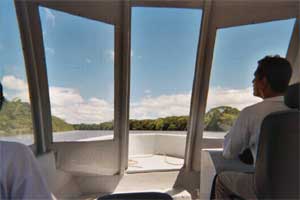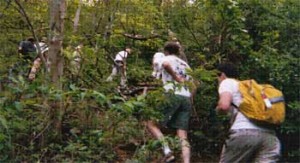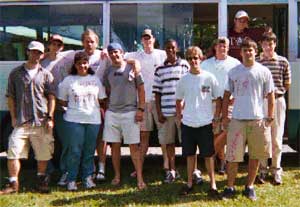By Monti Mercer ’06Dr. M. Carolina Y?er, Visiting Assistant Professor of Biology, parted from her family for two and half weeks to take eleven Hampden-Sydney men to Costa Rica for tropical biology research. We were able to perform studies on plants and animals found at three biological stations located around the country, each with its own tropical forest genre. The stations are run by the Organizations for Tropical Studies (OTS), a non-profit consortium that focuses on undergraduate and graduate level education in tropical biology.
Six days were spent on campus preparing for all the research that would be performed in Costa Rica. It was decided that we would break up into five research groups to conduct the experiments at each station. We got up early Sunday morning to catch our flight out of Richmond at 7:30 AM, only to have a seven hour layover in Miami. After we explored either the beach or the airport to pass the time, we finally turned back our watches two hours and walked off the plane into the Costa Rican capital, San Jose. We all made it through customs with no problems and were greeted outside the airport by a mass of the native people taking pictures and shouting, “Need Taxi?” A bus soon carried us away into the heart of San Jose where we would spend one night at hotel la Amistad (Friendship) before going to the first biological station, Palo Verde.
 During the four hour bus ride to the first station, the change in vegetation became evident. Palo Verde is a dry forest located in the northern section of Costa Rica on the pacific coast. Driving up to the main gates, a collection of dragon flies and iguanas were present to greet us. Settling at this station for four nights, we were provided with three rooms containing two sets of bunk beds per room, a fan, and our own bathrooms with no hot water. We were also given mosquito nets that fortunately weren’t of much need. Besides having to check the beds for scorpions every night, the annoying insects that seemed to be immune to DEET, and the long hot afternoons, we were able to make Palo Verde home for the given time. The five research groups spent the days hiking the different trials in order to obtain information on our topics. On the second day we took a boat ride down a river that dumps into the Pacific. A large variety of wild life can be spotted if you have a good eye. The river is crocodile infested; one of the guys was able to touch one from the boat. Three guys and Professor Yaber were able to sample raw shrimp sprinkled with fresh lime juice, caught by the boatman in the middle of the ride. The last day was spent writing papers and we gave presentations of the research that night. To take a break from research before going to the next research station, we found ourselves on another four hour trip to the beaches of Manuel Antonio, still on the Pacific side. It began to rain a few hours after our arrival. We had already agreed to spend this night together as a group, and the rain didn?t spoil that adventure. The next morning the guys met with Dr. Y?er to go to the beach inside the National Park. To our entertainment, as if the beach itself wasn’t enough, the guys watched a Squirrel Monkey climb down out of a tree, steal a package of Oreo cookies off a young lady’s towel, climb back up the tree, and enjoy the creme center. Guess he never heard of the Honor Code. After basking in the sun all morning, the group returned to the bus for yet another four hour drive.
During the four hour bus ride to the first station, the change in vegetation became evident. Palo Verde is a dry forest located in the northern section of Costa Rica on the pacific coast. Driving up to the main gates, a collection of dragon flies and iguanas were present to greet us. Settling at this station for four nights, we were provided with three rooms containing two sets of bunk beds per room, a fan, and our own bathrooms with no hot water. We were also given mosquito nets that fortunately weren’t of much need. Besides having to check the beds for scorpions every night, the annoying insects that seemed to be immune to DEET, and the long hot afternoons, we were able to make Palo Verde home for the given time. The five research groups spent the days hiking the different trials in order to obtain information on our topics. On the second day we took a boat ride down a river that dumps into the Pacific. A large variety of wild life can be spotted if you have a good eye. The river is crocodile infested; one of the guys was able to touch one from the boat. Three guys and Professor Yaber were able to sample raw shrimp sprinkled with fresh lime juice, caught by the boatman in the middle of the ride. The last day was spent writing papers and we gave presentations of the research that night. To take a break from research before going to the next research station, we found ourselves on another four hour trip to the beaches of Manuel Antonio, still on the Pacific side. It began to rain a few hours after our arrival. We had already agreed to spend this night together as a group, and the rain didn?t spoil that adventure. The next morning the guys met with Dr. Y?er to go to the beach inside the National Park. To our entertainment, as if the beach itself wasn’t enough, the guys watched a Squirrel Monkey climb down out of a tree, steal a package of Oreo cookies off a young lady’s towel, climb back up the tree, and enjoy the creme center. Guess he never heard of the Honor Code. After basking in the sun all morning, the group returned to the bus for yet another four hour drive.
 The Wilson Botanical Garden at Las Cruces is located in the south, about twenty miles north of the border with Panama. Four nights were spent here with spectacular accommodations for researchers. We had rooms for two with wooden floors and blinds, a balcony overseeing part of the forest, a bathroom with hot water, and a phone. Although, Las Cruces has the best accommodations out of the three stations, it was the most difficult to gather research topics. Since it is a botanical garden, most of its wild life is comprised of various plants and birds. There is division in the group over which station had better food, La Cruces or Palo Verde. La Cruces has more international style food compared to the typical Costa Rican food served in Palo Verde but it can be hard to please some international travelers especially when every Costa Rican meal contains beans and rice. We all enjoyed La Cruces and would not have been in a hurry to leave except the next stop was at a volcano.
The Wilson Botanical Garden at Las Cruces is located in the south, about twenty miles north of the border with Panama. Four nights were spent here with spectacular accommodations for researchers. We had rooms for two with wooden floors and blinds, a balcony overseeing part of the forest, a bathroom with hot water, and a phone. Although, Las Cruces has the best accommodations out of the three stations, it was the most difficult to gather research topics. Since it is a botanical garden, most of its wild life is comprised of various plants and birds. There is division in the group over which station had better food, La Cruces or Palo Verde. La Cruces has more international style food compared to the typical Costa Rican food served in Palo Verde but it can be hard to please some international travelers especially when every Costa Rican meal contains beans and rice. We all enjoyed La Cruces and would not have been in a hurry to leave except the next stop was at a volcano.
The nine hour bus ride north to the active Arenal Volcano turned out to be a great experience for those who could stay up. As the group got closer and closer to the volcano, we became surrounded by overcast and there was no change once we arrived at our destination. The school had already arranged for an elaborate candle light dinner, so we became indulged with that believing we wouldn’t see the volcano erupt. After dinner, a little before midnight, seven of us were relaxing in the Jacuzzi and celebrating one of the guy?s twentieth birthday, when we glimpsed a break in the clouds revealing fireworks shooting out of the mouth of Arenal into the empty black sky for a teasing five minutes.
We all watched Arenal in the morning light with hopes of seeing something red as we headed towards the last station in La Selva. Being in a tropical rainforest, La Selva is full of more species of plants and animals than Las Cruces and Palo Verde combined. The lab equipment available at this station was the best of the three stations; each group made efforts to use and learn about the different types of equipment. The best research projects were performed here and were comprised of the following subjects: Leaf-cutter Ants, Bullet Ants, Fig Wasp, and Helliconiae plants. The food  and living accommodations were least liked here out of the three stations and it rained a lot, but the students still enjoyed their stay. To celebrate the end of all of our research, the group played ultimate Frisbee and took their last hike through the tropical jungle together.
and living accommodations were least liked here out of the three stations and it rained a lot, but the students still enjoyed their stay. To celebrate the end of all of our research, the group played ultimate Frisbee and took their last hike through the tropical jungle together.
The Last day in Costa Rica was spent in San Jose. It was comforting to return back to our starting place, la Amistad. Most of the guys made use of time trying to see everything in the city before it was time to head towards the airport. We learned a lot from this trip, from increasing our own biological knowledge, to experiencing Costa Rican culture and customs. The guys began to discuss and really to respect true family values witnessed here. We were all ready to go home and share our experiences with friends and family. Thanks to Dr. Y?er and Hampden-Sydney we did it together in the brotherhood, and some of our experiences will never be forgotten.